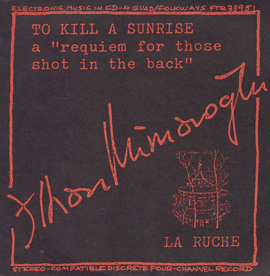Summary
Few American innovations have had as far-reaching and profound an impact on the world’s music as the drum set. Likely first used in the United States in the late 19th century and developed extensively throughout the first half of the 20th century, the drum set is now an international cultural icon. Most people (including many drum set players!) are surprised to learn that the drum set, as we know it today, owes much of its popularity to the development of jazz in New Orleans. This lesson provides an introduction to drum set history and teaches students to perform preliminary New Orleans brass band and early jazz drumming rhythms.
Suggested Grade Levels: 5-12
Country: United States of America
Region: New Orleans, Louisiana
Culture Group: American/African-American
Genre: Early Jazz/Dixieland, New Orleans Brass Band
Instruments: Drum Set, Drum Sticks, Body Percussion, Hands, Voice
Language: English, Instrumental
Co-Curricular Areas: Social Studies
National Standards: 1, 2, 3, 5, 6, 7, 8, 9
Prerequisites: None
Objectives:
- Learn the names and origins of the individual pieces of the drum set
- Learn about the early history of the drum set and its development
- Learn to perform and improvise a New Orleans brass band rhythm
- Learn to play an early drum set rhythm called the “shimmy beat” as performed by Baby Dodds
Material:
- “Spooky Drums No.1,” “Careless Love Blues,” and liner notes from Foot Notes to Jazz, Vol. 1: Baby Dodds Talking and Drum Solos (FW02290)
- “Lord, Lord, Lord” and liner notes from Music of New Orleans, Vol. 2: Music of the Eureka Brass Band (FW02462)
- “I’m Satisfied You Love Me” and liner notes from New Orleans Jazz: The Twenties (FWRBF 203)
- “Shake It and Break It” and liner notes from Music of New Orleans, Vol. 5: New Orleans Jazz: The Flowering (FW02465)
- Liner notes from Music of New Orleans, Vol. 4: The Birth of Jazz (FW02464)
- A world map and a map of the United States of America
- Drum set (bass drum and bass drum pedal, snare drum, tom toms, cymbals, hi-hats, mounted woodblocks (if available))
- If a drum set is not available, photos/videos of a drum set containing the above components
- Drum sticks
- Wire brushes or fly swatters (optional)
Other suggested Smithsonian resources for information on early jazz and the drum set:
- The article entitled “Jazz” by John Edward Hasse and Bob Blumenthal in Smithsonian Folkways Magazine
- Smithsonian Interactive Jazz Education Website
- Music and liner notes from Jazz/Some Beginnings - 1913-1926 (FWORF31)
- Music and liner notes from Classic Sounds of New Orleans from Smithsonian Folkways (SFW40183)
- Music and compendium for Jazz: The Smithsonian Anthology (SFW40820)
Lesson Segments:
- An Introduction to the Pieces of the Drum Set and Their Origins (National Standards 6, 7, 8, 9)
- Understanding the Development of the Drum Set in New Orleans (National Standards 6, 7, 8, 9)
- Performing Eureka Brass Band Drum Rhythms (National Standards 1, 2, 3, 5, 6, 7, 9)
- Learning to Play Baby Dodds’ “Shimmy Beat” (National Standards 1, 2, 5, 6, 7, 9)
Lesson Segment 1: An Introduction to the Parts of the Drum Set and Their Origins
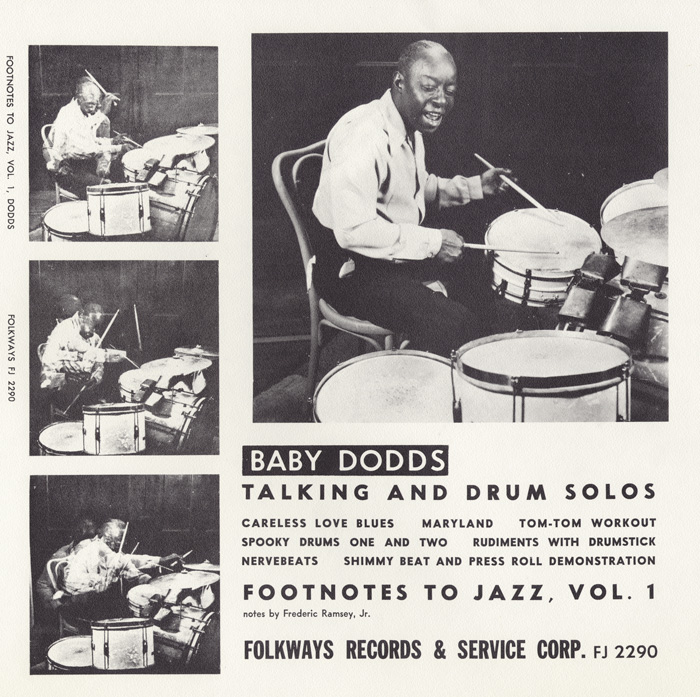
“Spooky Drums No.1”
from Footnotes to Jazz, Vol. 1: Baby Dodds Talking and Drum Solos (1951) | FW02290
“Careless Love Blues”
- Before listening to the music, present an actual drum set in class or do an internet search to find photos/videos of a drum set. At a minimum, a drum set or photos/videos of one should include a bass drum, snare drum, tom-toms, cymbal(s), and hi-hat cymbals. Ask students:
- Do you know what this whole instrument is called?
- Can you name any of the individual instruments that make up the set?
- Play the different parts of the set as you name them and then repeat and ask the students to call out their names as a learning game. If there is not a physical drum set in class, you can point to the parts in a photo in place of playing them.
- Ask the students to guess where the parts of the drum set originated.
- Explain where the parts of the drum set originated:
- Bass and snare drums come from European military bands.
- The colorfully painted tom-toms used in early drum sets were of Chinese origin (an internet image search for “Chinese tom toms” will provide photos).
- Drum set cymbals around the turn of the 20th century were most often from Turkey or China.
- Also common were a variety of noisemakers with various origins like woodblocks, triangles, tambourines, bells, and shakers.
- Using a map of the United States of America, locate New Orleans, Louisiana. Explain that the drum set first gained international appeal alongside the rise of early jazz from New Orleans.
- Show photos of early drum sets in the liner notes of New Orleans Jazz: The Twenties, Music of New Orleans, Vol. 4: The Birth of Jazz, and Music of New Orleans, Vol. 5: New Orleans Jazz: The Flowering.
![]()
![]()
![]()
![]()
![]()
- Play “Spooky Drums No. 1” by Baby Dodds and ask the students to try and identify the different sounds of the drum set.
- Ask the students which parts of the drum set they heard.
- Listen again and identify the parts as they are heard:
- Snare drum and bass drum (0:01 - 0:05)
- Cymbal (0:06 )
- Tom-toms (0:07 - 0:12 )
- Woodblocks and cymbal (0:13 - 0:24)
- Combination of parts (0:24 - 0:30)
ssessment: Gauge whether the students could remember the names of the different parts of the drum set and identify them on the recording. If a drum set is available, ask the students to close their eyes and call out the name of each part as you play them. Also, ask questions regarding timbre. Which parts of the drum set have a low-pitched sound (bass drum, tom-toms)? Which parts of the drum set have a high-pitched sound (woodblocks, snare drum)? Which parts of the drum set have a sharp sound (woodblocks, snare drum, cymbals)? Which parts of the drum set have a softer sound (bass drum, tom-toms)? Does the drum set sound like a melodic instrument or a rhythmic one? (It can be both; percussion can have a rhythmic and/or melodic role in music.)
Lesson Segment 2: Understanding the Development of the Drum Set in New Orleans
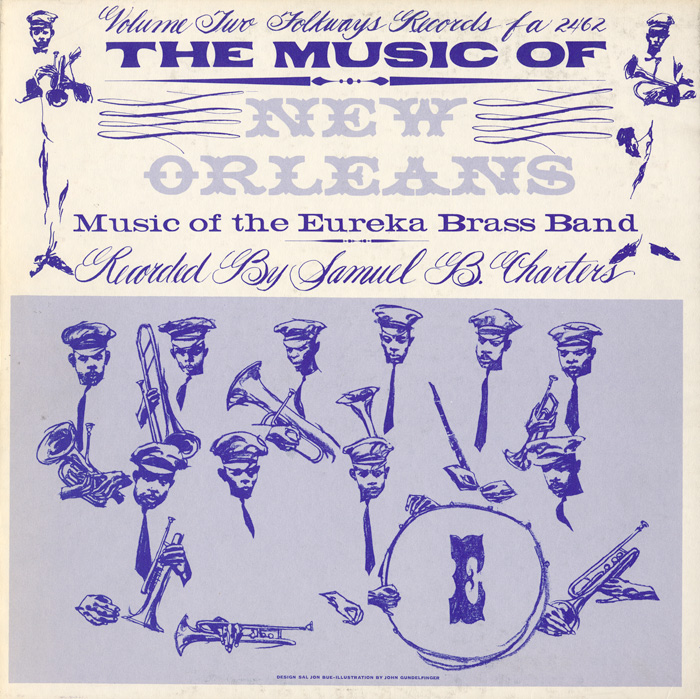
“Lord, Lord, Lord”
from Music of New Orleans, Vol. 2: Music of the Eureka Brass Band (1958) | FW02462
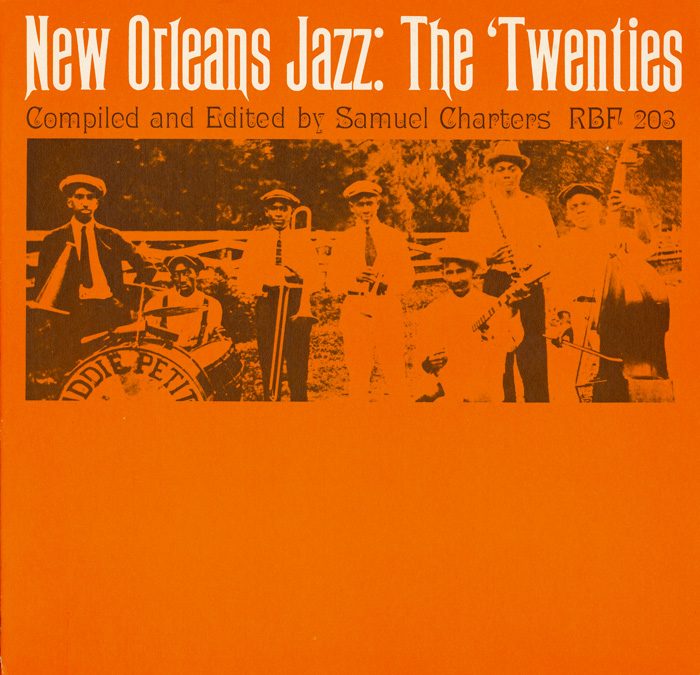
“I’m Satisfied You Love Me”
from New Orleans Jazz: The Twenties (1964) | FWRBF203
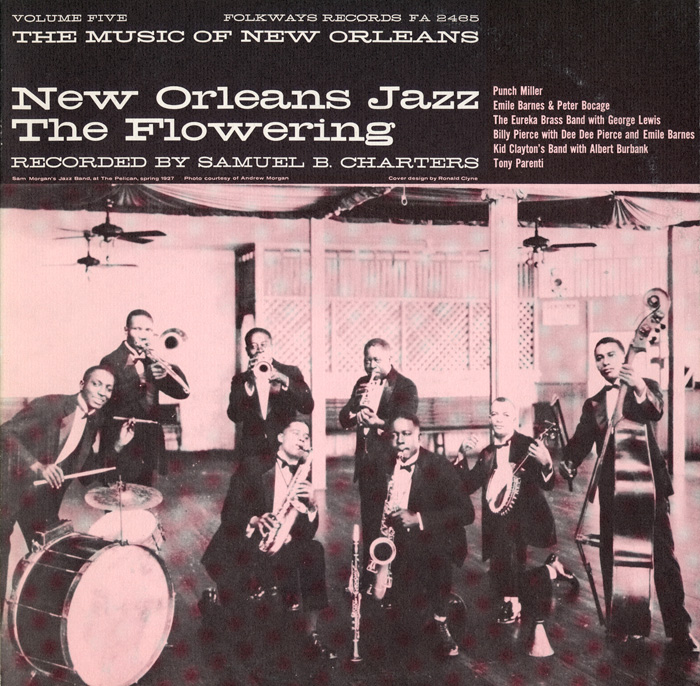
“Shake It and Break It”
from Music of New Orleans, Vol. 5: New Orleans Jazz: The Flowering (1959) | FW02465
- Play “Lord, Lord, Lord” by the Eureka Brass Band and listen.
- Ask the students if they hear a drum set in the recording. The answer is no.
- Explain that “Lord, Lord, Lord” featured Robert Lewis playing a bass drum and mounted cymbal while another drummer, Alfred Williams, played a snare drum. Although this recording was made in 1958, The Eureka Brass Band (founded circa 1920) played in a style typical of early New Orleans marching brass bands. Photos of the Eureka Brass Band and a 1919 photo of the Tuxedo Brass Band can be found in the liner notes of Music of New Orleans, Vol. 2: Music of the Eureka Brass Band.<
- Play “Shake It and Brake It” by Kid Clayton’s Band.
- Ask the students if they hear a drum set in the recording. The answer is yes. Although it was recorded in 1952, Alec Bigard’s playing in this recording exemplifies a style of jazz drumming from the early 20th century.
- Which parts of the drum set can be heard? Answers:
- Bass drum and snare drum (e.g., 0:01 - 1:06) with punctuated cymbal hits (e.g., 1:05 & 1:07)
- Woodblocks or the wooden rim of a drum (e.g., 1:07 – 1:18)
- Cymbal (e.g., 1:24 - 1:36)
- Play “I’m Satisfied You Love Me” by The Original Tuxedo Jazz Orchestra and listen. Show a photo of the group from the liner notes of New Orleans Jazz: The Twenties.
- Ask the students if they hear a drum set in the recording. The answer is yes. This recording, featuring Abbey Foster on drums, exemplifies another style of early jazz drumming.
- Which parts of the drum set can be heard? Answers:
- Woodblocks (0:01 - 1:06) with cymbal hits (0:05, 0:44, 0:46)
- Cymbal (1:07 – 1:47)
- Woodblocks (1:48 - end)
- In the late 19th century, multiple drummers were often found in the percussion section of American military bands and theater orchestras. However, due to space and budget restrictions, drummers became encouraged to play as many instruments as possible. This led to the invention of a style of playing known as “double drumming,” or a single performer alternating with sticks between a bass drum and snare drum. In the late 1880s, crude bass drum pedals in the United States enabled drummers to simultaneously play the snare drum with their hands and the bass drum with their feet. This “contraption” and the various noisemakers that could be attached to it became known as the “trap” set. Although bass drum pedals existed in England as early as the 1840s, the trap drummers of the 1890s seem to have been the first to put it to regular use. The improvement of the pedal in 1909 by the Ludwig & Ludwig, Inc. Drum Company of Chicago then increased its appeal and enabled mass distribution. These initial innovations began the development of the modern drum set.
However, the proliferation of the drumset can be linked to the rise of jazz in New Orleans and the international popularity that it gained in the early part of the 20th century. Research indicates that in the mid-1890s, Edward “Dee Dee” Chandler popularized the trap set in New Orleans when he began using an overhanging wooden bass drum pedal with the John Robichaux Orchestra (an internet image search for “Dee Dee Chandler bass drum pedal” will provide the only known photo of Chandler and this pedal). Bass drum pedals became widely used by small ragtime and dixieland bands that did not march. Having one drummer do the job of two drummers also meant that a bandleader had one less person to pay!
Smaller, quieter groups led to drummers using a variety of timbres and attachments like woodblocks, bells, and cymbals that could be played at low volumes and still be heard through the sound of the other instruments in the band. Using fly swatters or wire brushes was also as a way to play the drum set without overpowering quieter instruments at live performances and on recordings (if available, present wire brushes or fly swatters and strike and brush the drums to display how the volume is significantly lower than striking with sticks). Eventually tom-toms and a pedal-operated hi-hat cymbal device (originally called a “low boy” because the cymbals were only 12 inches off the ground; try an internet image search for “drum set low boy” and its predecessor the “snowshoe pedal”) were incorporated as well.
Assessment: Question the students about what factors led to the invention and early popularity of the drum set (answers include: desire to have smaller groups, invention of the bass drum pedal, production of a standardized metal bass drum pedal, having one less band member to pay) and what effects the new instrument had on music in New Orleans (answers include: smaller groups, quieter groups, groups with drums that did not march, new instruments and timbres used for rhythm (e.g. woodblocks, tom-toms, hi-hats), use of wire brushes/fly swatters)
Lesson Segment 3: Performing Eureka Brass Band Rhythms
![]()
![]()
- Listen to “Lord, Lord, Lord” again and look at photos of the Eureka Brass Band from the liner notes.
- Explain the use of two drummers in the marching band and have the students identify the sounds and rhythms of the bass drum and “clanger” cymbal (cymbal mounted on the marching bass drum) player and the snare drummer. An internet search for “Eureka Brass Band marching bass drum New Orleans” will provide clear photos of the “clanger” cymbal.
- Listen for and pay close attention to the bass drum part (note: the recording contains variations, but playing the basic transcribed part is sufficient for this lesson).
- Use the bass drum transcription to play along with the track (students can play with one of their hands on their chest or thigh to mimic a low bass drum sound).
- Listen for and practice the bass drum variation (0:22 - 0:24). Try alternating between the basic pattern and the variation without pausing between the two. Start practicing at a slow tempo and gradually speed up.
- Clap the “clanger” rhythm in time with the music.
- Lead the students in playing the bass drum rhythm with one hand on their chest or thigh and the “clanger” rhythm with their other hand on another body part. Attempt the variation as well. Start practicing at a slow tempo and gradually speed up. Practice with and without the music.
- With drum sticks in the right hand (RH) and left hand (LH), play the snare drum rhythm on a snare drum or hard surface in time with the music. If the technique of a press/buzz roll with sticks is too difficult, students can make a buzzing noise with their mouth to imitate the roll in the LH. Start practicing at a slow tempo and gradually speed up. Practice with and without the music (note: the recording contains variations on the snare drum, but students can keep to the basic pattern for learning purposes). This could also be performed on thighs, or a desk/table, with hands instead of sticks.
- Split the class into two groups. Have one group play the bass drum and “clanger” part while the other group plays the snare drum part. Start practicing at a slow tempo and gradually speed up. Have the two groups switch parts and repeat. This step mimics how the two drummers on the recording perform these parts.
Assessment: Gauge how accurately the students were able to perform each part individually and as a group. Was everyone playing in time together? Did the rhythms begin to have a similar feel to the music? Could the class play the parts at a tempo near the recording?
![]()
Guide to notation: Each symbol between bar lines represents one eighth note. A letter (e.g. x, or z) signifies a played beat. A dash ( - ) signifies a rest. z z shows two snare press/buzz roll notes tied together.
Lesson Segment 4: Learning to Play Baby Dodds’ “Shimmy Beat”
- Show a photo of Baby Dodds from the liner notes and introduce Dodds as an influential early jazz drummer who played with many jazz greats such as Louis Armstrong, Jelly Roll Morton, and Sidney Bechet. Born in New Orleans in 1898, Dodds grew up listening to and learning from many of the first drum set players. His style of playing became very popular and helped advance the role of the drum set in jazz and popular music. Notice that in the photos Dodds is using a more modernized version of the drum set than the early drum set photos from lesson segment 1. More information on Baby Dodds can be found in the liner notes of Foot Notes to Jazz, Vol. 1: Baby Dodds Talking and Drum Solos.
![]()
- Listen to “Careless Love Blues” and use the same approach as lesson segment 3 to learn how to play the transcribed parts. Dodds calls the basic rhythm he is playing the “shimmy beat.” Again, the recording contains variations, but playing the basic transcribed pattern (0:01 - 0:15) is sufficient for this lesson.
- Try playing the bass drum part.
- Try playing the snare drum part.
- Try playing the bass drum part by tapping a foot while playing the snare drum part with drum sticks or hands.
- Highlight the similarity between the Eureka Brass Band rhythms for two drummers and Dodds’ “shimmy beat” for one drummer. The drum set rhythm played by Dodds in “Careless Love Blues” is at a slower tempo but is nearly identical to the basic rhythms for two drummers in “Lord, Lord, Lord” by the Eureka Brass Band. Early use of the drum set in New Orleans and its similarity and connection to marching band rhythms should become clear.
Assessment: Gauge the students’ ability to coordinate multiple limbs in performance. Did the rhythms begin to have a similar feel to the music? Could the class play the parts at a tempo near the recording? Do the students recognize the similarity between the rhythms in “Careless Love Blues” and “Lord, Lord, Lord”?
![]()
Guide to notation:Each symbol between bar lines represents one eighth note. A letter (e.g. x, or z) signifies a played beat. A dash ( - ) signifies a rest. z z shows two snare drum press/buzz roll notes tied together.






